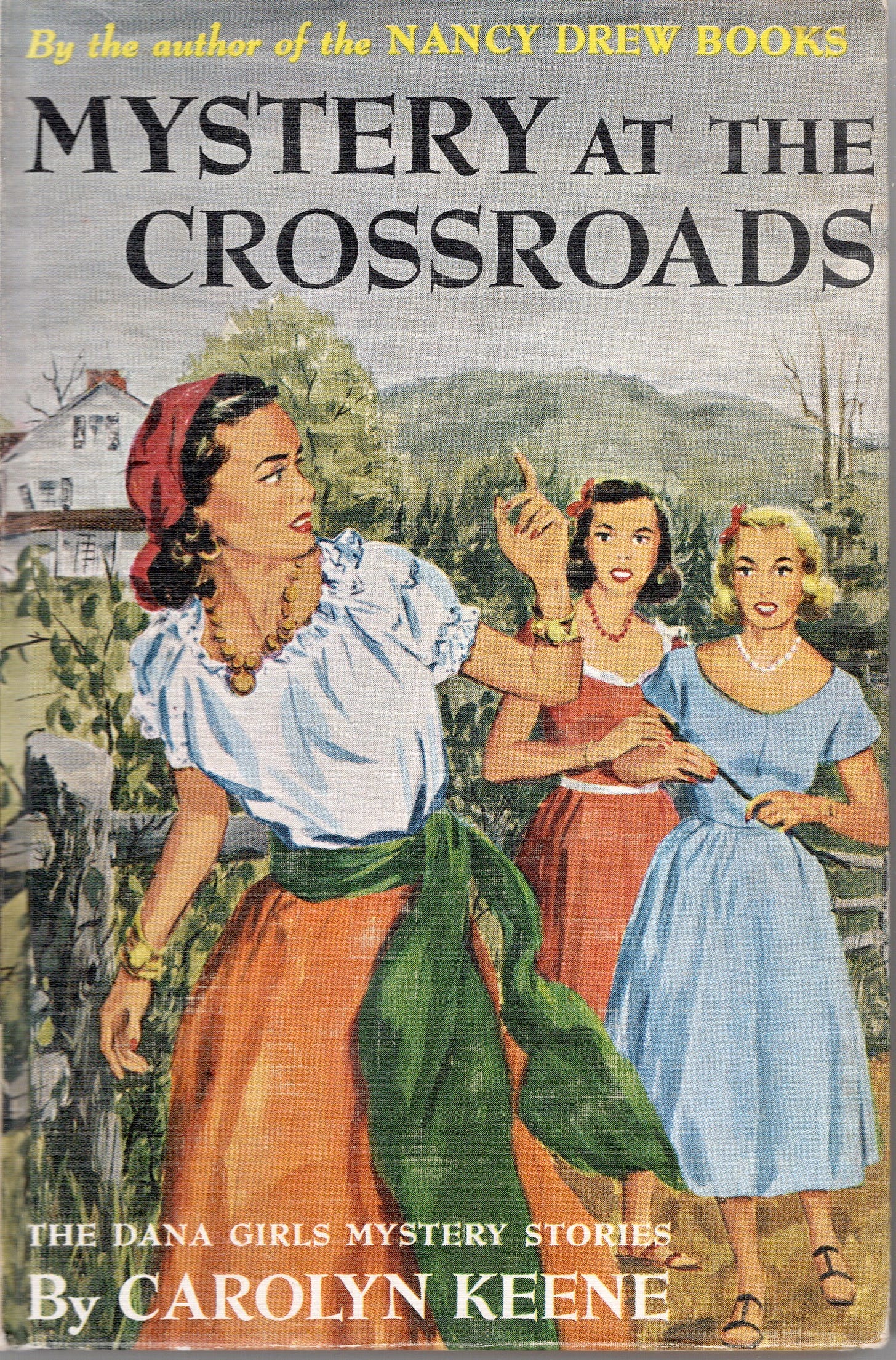Two Sisters
The first experience I had with the Dana Girls series was volume 13 (I think): The Secret in the Old Well. In the fourth grade, there was a table of books for kids in the back of the room that we could borrow to read (on that table is also where I discovered Nancy Drew). I read it, wasn’t terribly impressed by it—but as a child with all kinds of things going on in my mind, I was a completist; if I started a series I needed to finish it, as well as collect the series. I don’t have complete sets of any of these; after Katrina I obsessively began hunting the books I didn’t have…but that fervor has worn off. I do sometimes look at the used books in thrift shops and sometimes will find a nice edition of one of these old books—which is how I found Mystery at the Crossroads, with its offensive stereotype cover, and whoa boy, is this book ever offensive.
“We’re lost, Jean!”
“Sh, Doris! Don’t let Professor Crandall hear you.” Blond, vivacious Jean Dana turned to the girl beside her on the rear seat of the Starhurst School station wagon. “You’ll hurt his feelings.”
Jean nodded toward the driver. Beside him was Jean’s elder sister, dark-haired, serious-minded Louise. Doris Harland, who did not relish the thought of being lost in this deserted wooded area, was seated between Jean Dana and Evelyn Starr. The Starr family had once owned the extensive estate which was now the site of the well-known boarding school.
Spoiler: they are lost, and wind up at a strange, abandoned, and supposedly haunted in at a crossroads, where they encounter a “gypsy” girl, Nura, who draws them into the strange mystery at the crossroads.
The book was originally published in 1954, around the time the Stratemeyer Syndicate began revising the original Nancy Drew/Hardy Boys books to remove offensive language and stereotypes—racial caricatures, as it were, so it kind of surprised me that they released this one. I suppose for the time it tried its best to dilute the stereotypes of the “gypsies” and inform the young reader about the Romani—which it does mention, and it also talks about where they originally came from, trying to inform while at the same time educate properly…but I cringed every time I saw the G word, or it talked about their customs, which I think were mostly wrong. And yes, it really bothered me that this was a book for kids, that kids read, and took away harmful language and stereotypes.
I am often taken aback when reading an older book to see what the prevailing attitudes—towards men, women, etc.—were at the time (wait till I finish my reread of Moonraker, Lord), so we can see how society has changed since then and even understand how the breaking down of those prevailing attitudes was so important for our growth as a culture and society. (Likewise, Gone with the Wind should be studied and deconstructed for its content and attitudes; but I will never read that book again—and it’s vastly different from the movie, which is what most people know anyway.)
I never cared for the Dana Girls that much, to be honest. It was an outright cash grab (hey, the Nancy Drew and Hardy Boys books are successful, so how about a series about two sisters?) to begin with, and they even claimed they were written by the same writer as Nancy Drew for a marketing tool. But Jean and Louise were just like Frank and Joe: one blond, one brunette; one adventurous and impulsive, the other more serious. Their parents were dead but the deaths are never explained; when they are not at boarding school they live with their maiden Aunt Harriet (who has a bumbling comic relief maid named Cora Appel, and really, the way she is teased is actually kind of mean) and their Uncle Ned, who is captain of the steamship Balaska, and often away. How do they afford this exclusive boarding school? And the ghostwriters never really seemed to do more than paint by numbers; most of the characters are so interchangeable it’s hard to tell them apart.
And while Nancy was very independent, the Danas are in boarding school and always needing permission to leave campus. They most always get it, but they are very much rule-followers and not role models for young women.
The series failed three times. It originated just before the Second World War and was cancelled; then revived again; and was rebooted in the 1970s for the last time, dropping the first 16 titles in the series rather than rewriting them.
But…I am a completist.
They also always stumbled into their mysteries—getting lost, something to do with Uncle Ned’s latest voyage, odd pieces of furniture—and kind of lucked their way into solving them all without much deductive reasoning work, which I also found tiresome.
I’m glad I read this, though. My brain has been scrambled since I got sick and am having trouble focusing to read, so I am hoping I can get back to reading something I want to now.





